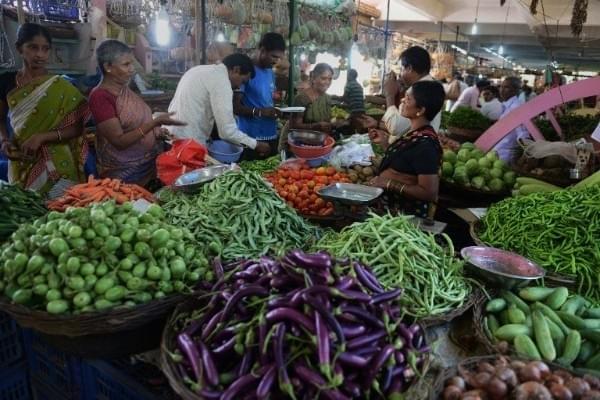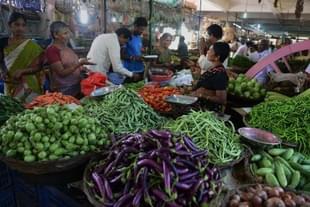Economy
What Agriculture Needs Is ‘E-NAM-dari’
Pratyasha Rath
Jun 07, 2018, 05:47 PM | Updated 05:47 PM IST
Save & read from anywhere!
Bookmark stories for easy access on any device or the Swarajya app.


What is the hallmark of a happy farmer?
That she is getting the right price for her produce.
And how do you think the government will benefit from a happy farmer?
By way of a direct, fulfilling relationship, facilitated through the mechanism of a minimum support price (MSP), which is the minimum price at which the government promises to pay the farmer for her produce, whatever be the prevailing market condition.
This has been the standard template of production and price-centric focus that has dominated agriculture in India since early 2006. There are two intrinsic problems with both these approaches. First, higher production does not necessarily lead to higher incomes. Second, pricing solutions do not lead to sustainable increase in incomes. While MSP or input price-based changes are easy and politically more prudent, it is not possible or feasible to skew terms of trade in favour of one sector in the long run.
The government has set an ambitious target of doubling farmers’ incomes by 2022. The NITI Aayog has identified six areas wherein critical reforms on agriculture are necessary. These include trade reforms, market reforms, resource access (or factor market access), improvement in the forestry sector, research and development, and extension services. Therefore, the focus has to move towards non-pricing solutions, which will make agriculture more efficient. The bridge between improved production and effective pricing is marketing, and this critical bridge has been neglected for a long time. Therefore, agri-marketing reforms need a major thrust so that the gap between production and pricing is bridged effectively.
Agri-marketing reforms have been the focus of the government since 2016, and they began with the setting up of the ambitious National Agricultural Market or E-NAM.
E-NAM and the quest for one market
E-NAM is a pan-Indian electronic trading portal which aims at connecting the existing Agriculture Produce Marketing Committee (APMC) mandis across the country so that there is a unified national market for agricultural commodities.
It is common knowledge that much of what is of value in agricultural reforms comes under the domain of state governments. Agri-marketing in particular is governed by the agri-marketing regulations of specific states. Every state is divided into market zones which are governed by an APMC. Each APMC has its set of rules, including trading fees. Therefore, think of the number of markets across the country, the number of rules, the fees, and how difficult it will be for a trader to navigate through all of it. So, if a farmer from Odisha wants to trade high-quality turmeric in Himachal Pradesh, she will have to pay multiple fees which will add to the final cost of the product for the consumer. But she will not get any part of that final price as there are too many actors en route. E-NAM aims at addressing these concerns by creating one unified market.
Before the pan-Indian integration, the government started with a single state licence so that all mandis within a state can be integrated and trading can happen across the APMCs there.
Progress of E-NAM
It has been two years since E-NAM was introduced, but the progress leaves much to be desired. The current budget revised the target to ensure that 585 mandis across India would be integrated into E-NAM by 2018. By December 2017, 14 states had amended their APMC Acts to bring in three key changes: a single licence across the state, a single-point levy for market fees, and a provision for e-auction. A total of 470 mandis across 14 states had been integrated into the e-auction system. By mid-February, this number had increased to 519, including 17 mandis from West Bengal, which are pending approval from the government. While the target seems attainable by March 2019, it covers a very small portion of regulated markets in the country.
While some states such as Haryana and Maharashtra seem to be adapting rather fast, there is no doubt that the overall progress on integration is extremely slow. West Bengal has not amended its APMC Act effectively to be eligible for participation while Karnataka has declined to be a part of the scheme because it already has a successful scheme called Rashtriya E-Market Services (ReMS). Since cross-state trade has not begun, Karnataka did not feel the need to join at this stage. Kerala and Bihar, which do not have any APMC Acts, have agreed in principle to be a part of the process, but there is tardy progress in fixing regulations. There has been no interest shown by the Punjab government yet.
Stealth reforms on the way?
One of the interesting initiatives of the government, which could possibly bypass the messy route of APMCs, is the establishment of 22,000 gramin agricultural markets (gram) as announced in the budget this year. This scheme is meant for the smaller farmers who cannot trade at APMCs and usually trade at rural haats. Under this scheme, the haats would be upgraded using labour inputs from Mahatma Gandhi National Rural Employment Guarantee Act (MGNREGA) and then linked to E-NAM. A farmer would benefit more if she could directly sell to bulk buyers or exporters or even to industries who could process her produce. The involvement of middlemen in the transactions takes away the profit margin of farmers. Rural haats are extremely disorganised and small farmers who cannot travel to mandis at a distance usually have to make do with periodic markets and inadequate infrastructure. The small quantities of produce do not give them good returns and often there aren’t enough buyers.
Integration into E-NAM by bypassing state laws could be a welcome initiative for small farmers who could get more remunerative prices for their produce. But there are a lot of small and marginal farmers who produce fruits and vegetables and only 14 states so far have deregulated marketing of fruits and vegetables from APMCs. This could potentially prove to be a roadblock and again put the ball in the court of the states.
While it is still unclear how the central government plans to bypass the state laws and integrate markets, this could be a reform in tiptoes which is waiting in the wings. Could this be the path that will lead towards direct sale by producers irrespective of land-holding size by bypassing APMC regulations? That remains to be seen.
Slow pace of reforms in states
So, why has a simple set of three reforms taken so much time? Essentially, there are many more things that need to be done to improve agri-marketing, such as making licensing simpler and setting up private mandis or removing APMC discretion on contract farming. But, unlike many cases, in case of E-NAM, the Centre even provided incentives in the form of Rs 30 lakh a mandi apart from merely persuading states to make three changes in the APMC Act. But the follow-up has been extremely slow, to say the least.
The lack of reforms in states boils down to political will. APMCs across states are dens of political patronage and that is evident from the importance given to the APMC elections and the clout of nominated or elected leaders. APMCs are a huge part of political funding in the states and any reforms would dilute the powers of the entrenched actors in these setups. The second issue is similar to the backlash that happened in the case of the goods and services tax (GST). Farmers and traders are change-averse and getting used to technology might need a lot of individual adaptation. The central government cannot enforce any such rules and, apart from persuasion, it can only can take the route of incentives to make states take up these reforms fast. The states will have to build some political will to get going themselves.
Way ahead
There is no simple way to make states respond to reforms with urgency. However, the best way out seems to have been suggested by the Dalwai committee. There is a need to bring agricultural marketing under the concurrent list from the state list so that the Centre can have a greater say in the affairs. Marketing, unlike farming, is not dependent on geographic silos and, hence, requires a more centralised focus. Based on the recommendations of the committee, the Centre has already prepared the Model Agricultural Produce and Livestock Marketing (APLM) Rules, 2017, and placed it before the states. The model Act focuses on post-production and aims at doing away with the fragmented approach to agri-marketing which has suppressed farmer incomes for decades.
There are provisions already for enhanced credit for farmers and agri-entrepreneurs in allied industries as highlighted in the budget. The budget for development of agri-logistics as well as supply-chain augmentation, including improved storage and transportation facilities, has received a fillip. There is a plan in place to improve rural haats and make them more producer-friendly. The model APLM Act provides space for private players to enter the field and help build an appropriate market structure.
The Centre is doing its bit, but the states need to keep up. This is the biggest test of cooperative federalism, which will ultimately decide whether our farmers can get out of the rut they are in and whether their incomes can actually be doubled by 2020.
*Figures from March 2018
Pratyasha Rath is a consultant working in the social development and political sector.




